Skip to content
Quadrilaterals and triangles
Exercises
Problem set
- In the following figure,
 is a straight line segment and
is a straight line segment and  is a parallelogram. What is the area of the parallelogram
is a parallelogram. What is the area of the parallelogram  ?
?
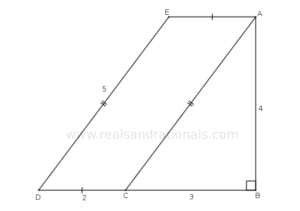
- In the following figure,
 is a rectangle,
is a rectangle,  and
and  is a straight line segment. What is the area of the quadrilateral
is a straight line segment. What is the area of the quadrilateral  ?
?
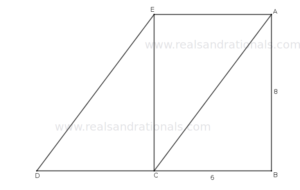
- In the following figure,
 are parallelograms. Which of the parallelograms has the smallest area?
are parallelograms. Which of the parallelograms has the smallest area?
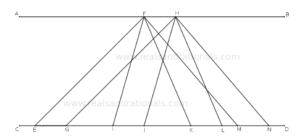
- In the following figure,
 is a parallelogram. What is the length of
is a parallelogram. What is the length of  ?
?
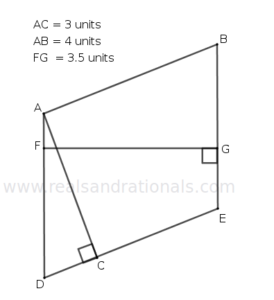
Problem set
- In the following figure,
 is a straight line segment.
is a straight line segment.
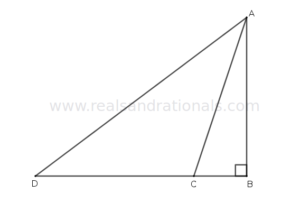
- If
 units and
units and  units and area of
units and area of  square units, what is the length of
square units, what is the length of  ?
?
- If
 units and
units and  units, what is the area of
units, what is the area of  ?
?
 is a parallelogram with area
is a parallelogram with area  square units.
square units.  is a point on
is a point on  . What is the area of
. What is the area of  ?
?- In the following figure,
 is a straight line segment. Which of the following triangles is biggest in area:
is a straight line segment. Which of the following triangles is biggest in area:  ?
?
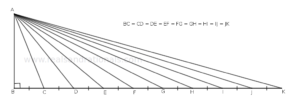
- In the following figure,
 and
and  are straight line segments. What is the area of the quadrilateral
are straight line segments. What is the area of the quadrilateral  ?
?
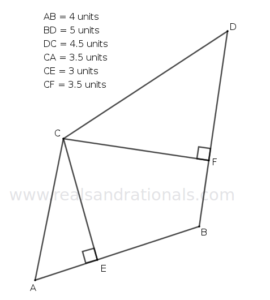
Problem set
- In
 ,
,  is the mid-point of
is the mid-point of  .
.  is some point on
is some point on  . If area of
. If area of  is
is  square units and area of
square units and area of  is
is  square units, calculate the area of
square units, calculate the area of




Problem set
- In the following figure,
 , and the area of the trapezoid
, and the area of the trapezoid  is
is  square units. What is the area of
square units. What is the area of  ?
?
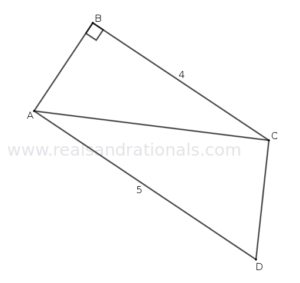
 is a parallelogram and
is a parallelogram and  is a point lying inside the parallelogram.
is a point lying inside the parallelogram.
- Prove that areas of
 and
and  add up to half the area of the parallelogram.
add up to half the area of the parallelogram.
- If area of
 is
is  square units, area of
square units, area of  is
is  square units and area of
square units and area of  is
is  square units, what is the area of
square units, what is the area of  ?
?
 is a quadrilateral and
is a quadrilateral and  and
and  are mid-points of
are mid-points of  and
and  respectively. Prove that the area of the quadrilateral
respectively. Prove that the area of the quadrilateral  is half the area of the quadrilateral
is half the area of the quadrilateral  .
. is a quadrilateral whose diagonals
is a quadrilateral whose diagonals  and
and  intersect at
intersect at  such that
such that  .
.
- Prove that areas of
 and
and  are equal.
are equal.
- Prove that areas of
 and
and  are equal.
are equal.
- If area of
 is
is  square units and the area of
square units and the area of  is
is  square units, what is the area of the quadrilateral
square units, what is the area of the quadrilateral  ?
?
 is a trapezoid with
is a trapezoid with  . The diagonals
. The diagonals  and
and  intersect at
intersect at  .
.
- Prove that areas of
 and
and  are equal.
are equal.
- If the area of the trapezoid
 is
is  square units, the area of
square units, the area of  is
is  square units and the area of
square units and the area of  is
is  square units, find the areas of
square units, find the areas of  and
and 
 is a trapezoid with
is a trapezoid with  .
.  and
and  are respectively the mid-points of
are respectively the mid-points of  and
and  . Prove that the triangles
. Prove that the triangles  and
and  have equal areas.
have equal areas.
Problem set
- In the following figure,
 is a straight line segment,
is a straight line segment,  is a parallelogram and
is a parallelogram and  . What is the area of the parallelogram
. What is the area of the parallelogram  ?
?
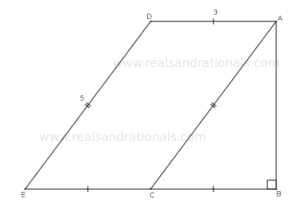
- In the following figure,
 is a straight line segment and
is a straight line segment and  is a parallelogram. What is the area of the parallelogram
is a parallelogram. What is the area of the parallelogram  ?
?
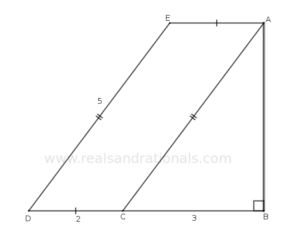
- In the following figure,
 is a rectangle,
is a rectangle,  and
and  is a straight line segment. What is the area of the quadrilateral
is a straight line segment. What is the area of the quadrilateral  ?
?
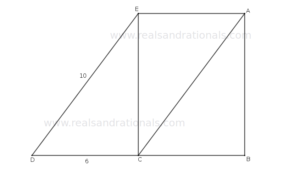
- In the following figure,
 is a straight line segment. If
is a straight line segment. If  units,
units,  units and area of
units and area of  square units, what is the length of
square units, what is the length of  ?
?

Ratios of areas to lengths
Exercises
Problem set
- Two squares are such that the side of one square is double that of the other square.
- What is ratio of their perimeters?
- What is the ratio of their areas?
- Two circles are such that the diameter of one circle is three times the diameter of the other.
- What is ratio of their perimeters?
- What is the ratio of their areas?
- A rectangle and a square have the same area. The length of the rectangle is three times the side of the square. What is the ratio of the length to the width of the rectangle?
- A rectangle and a square have the same perimeter. The width of the rectangle is half the side of the square. What is the ratio of the length to the width of the rectangle?
- Base of a triangle is three times the height of the triangle. Its area is
 square units. What is the base of the triangle?
square units. What is the base of the triangle?
- Base of a triangle is half the height of the triangle. Its area is
 square units. What is the height of the triangle?
square units. What is the height of the triangle?
Problem set
- The perimeter of a circle is
 units while the area of the circle is also
units while the area of the circle is also  square units.
square units.
- What is the value of
 ?
?
- What is the radius of the circle?
- The perimeter of a circle is
 units while the area of the circle is
units while the area of the circle is  square units.
square units.
- What is the value of
 ?
?
- What is the radius of the circle?
- Length of a rectangle is seven times its width. Its perimeter is
 units. What is its length?
units. What is its length?
- Ratio of length to width of a rectangle is
 . Area of rectangle is
. Area of rectangle is  square units. What is its perimeter?
square units. What is its perimeter?
- If the side of a square is doubled, what is the ratio of the area of the original square to the area of the new square?
- Two circles are such that the circumference of first one is one-third the circumference of the second one. What fraction of the area of the second circle is the area of the first circle?
Miscellaneous
Exercises
Problem set
- In the following figure,
 is a rectangle. What is the area of trapezoid
is a rectangle. What is the area of trapezoid  ?
?
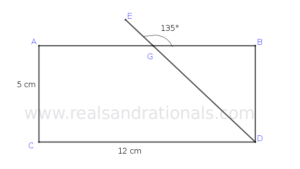
- Sides of a pentagon are in the ratio
 . Its perimeter is
. Its perimeter is  units. What is the median of the sides of the pentagon?
units. What is the median of the sides of the pentagon?
- An isosceles right triangle has area
 square units. What is its perimeter?
square units. What is its perimeter?
Problem set
- What is the area of the following triangle?
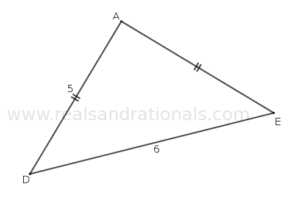
- In the following figure,
 is a parallelogram. What is its area?
is a parallelogram. What is its area?
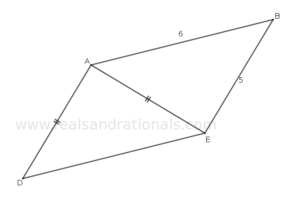
- In the following figure,
 is a parallelogram. What is its area?
is a parallelogram. What is its area?
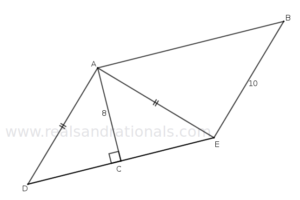
- In the following figure,
 is a parallelogram. What is its area?
is a parallelogram. What is its area?
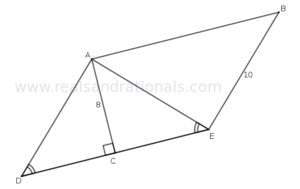
- In the following figure,
 is a parallelogram. What is its area?
is a parallelogram. What is its area?
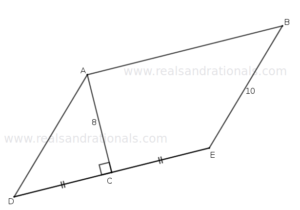
Problem set
- What is the area of a regular hexagon whose side is
 units?
units?
- In the following figure,
 is a straight line segment,
is a straight line segment,  and
and  . What is the area of the quadrilateral
. What is the area of the quadrilateral  ?
?
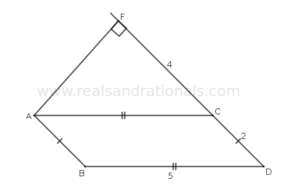
- In the following figure,
 is a parallelogram. What is the length of
is a parallelogram. What is the length of  ?
?
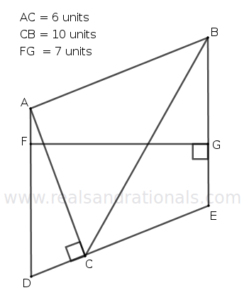
- In the following figure,
 is a parallelogram. What is its area?
is a parallelogram. What is its area?
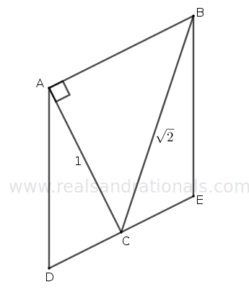
- In the following figure,
 ,
,  ,
,  ,
,  and
and  . What is the area of the portion of the figure that is colored gray?
. What is the area of the portion of the figure that is colored gray?
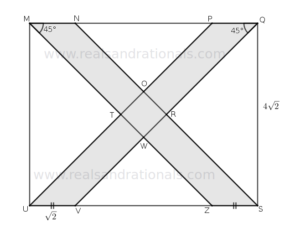
Problem set
- In the following figure,
 and
and  are two squares. And,
are two squares. And,  is the center of the square
is the center of the square  . What is the ratio of area of square
. What is the ratio of area of square  to the area of square
to the area of square  ?
?
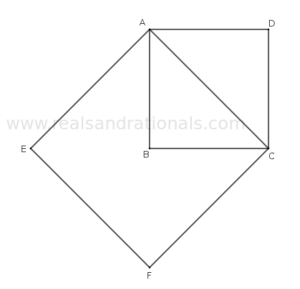
- In the following figure,
 is a regular hexagon. What is the area of the quadrilateral
is a regular hexagon. What is the area of the quadrilateral  ?
?
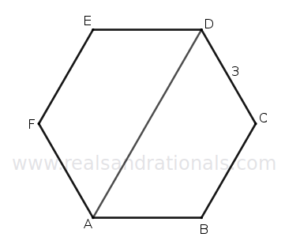
- In the following figure,
 is a regular hexagon.
is a regular hexagon.  and
and  are midpoints of
are midpoints of  and
and  respectively. What is the area of the polygon
respectively. What is the area of the polygon  ?
?
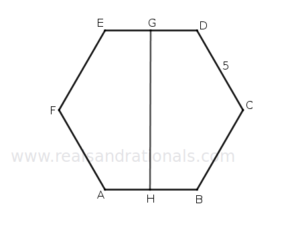
- Following figure shows a circle and a square inscribed in the circle. What is the area of the shaded portion?
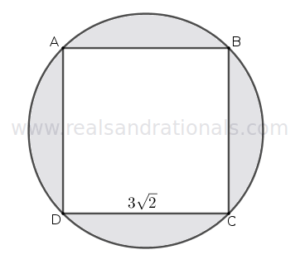
- Following figure shows a square and a circle inscribed in the square. What is the area of the shaded portion?
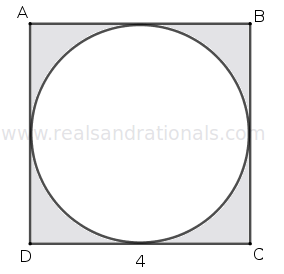
is a straight line segment and
is a parallelogram. What is the area of the parallelogram
?

is a rectangle,
and
is a straight line segment. What is the area of the quadrilateral
?

are parallelograms. Which of the parallelograms has the smallest area?

is a parallelogram. What is the length of
?

is a straight line segment.

units and
units and area of
square units, what is the length of
?
units and
units, what is the area of
?
is a parallelogram with area
square units.
is a point on
. What is the area of
?
is a straight line segment. Which of the following triangles is biggest in area:
?

and
are straight line segments. What is the area of the quadrilateral
?

,
is the mid-point of
.
is some point on
. If area of
is
square units and area of
is
square units, calculate the area of
, and the area of the trapezoid
is
square units. What is the area of
?

is a parallelogram and
is a point lying inside the parallelogram.
and
add up to half the area of the parallelogram.
is
square units, area of
is
square units and area of
is
square units, what is the area of
?
is a quadrilateral and
and
are mid-points of
and
respectively. Prove that the area of the quadrilateral
is half the area of the quadrilateral
.
is a quadrilateral whose diagonals
and
intersect at
such that
.
and
are equal.
and
are equal.
is
square units and the area of
is
square units, what is the area of the quadrilateral
?
is a trapezoid with
. The diagonals
and
intersect at
.
and
are equal.
is
square units, the area of
is
square units and the area of
is
square units, find the areas of
and
is a trapezoid with
.
and
are respectively the mid-points of
and
. Prove that the triangles
and
have equal areas.
is a straight line segment,
is a parallelogram and
. What is the area of the parallelogram
?

is a straight line segment and
is a parallelogram. What is the area of the parallelogram
?

is a rectangle,
and
is a straight line segment. What is the area of the quadrilateral
?

is a straight line segment. If
units,
units and area of
square units, what is the length of
?

square units. What is the base of the triangle?
square units. What is the height of the triangle?
units while the area of the circle is also
square units.
?
units while the area of the circle is
square units.
?
units. What is its length?
. Area of rectangle is
square units. What is its perimeter?
is a rectangle. What is the area of trapezoid
?

. Its perimeter is
units. What is the median of the sides of the pentagon?
square units. What is its perimeter?

is a parallelogram. What is its area?

is a parallelogram. What is its area?

is a parallelogram. What is its area?

is a parallelogram. What is its area?

units?
is a straight line segment,
and
. What is the area of the quadrilateral
?

is a parallelogram. What is the length of
?

is a parallelogram. What is its area?

,
,
,
and
. What is the area of the portion of the figure that is colored gray?

and
are two squares. And,
is the center of the square
. What is the ratio of area of square
to the area of square
?

is a regular hexagon. What is the area of the quadrilateral
?

is a regular hexagon.
and
are midpoints of
and
respectively. What is the area of the polygon
?


